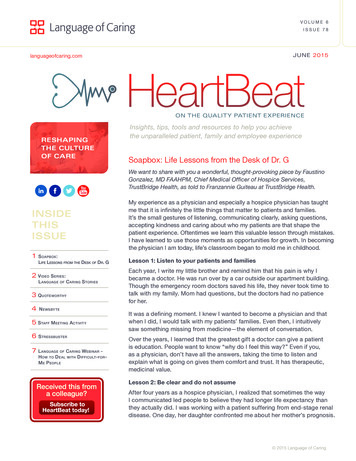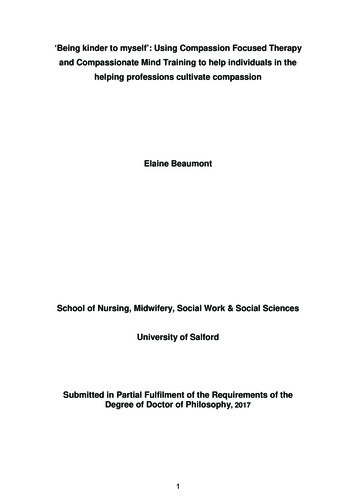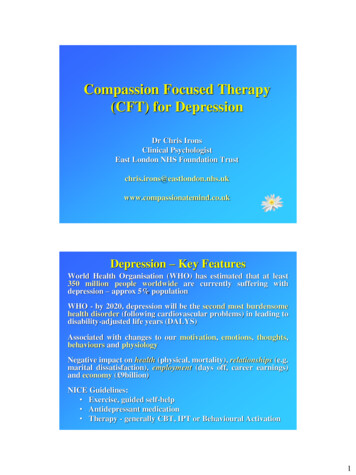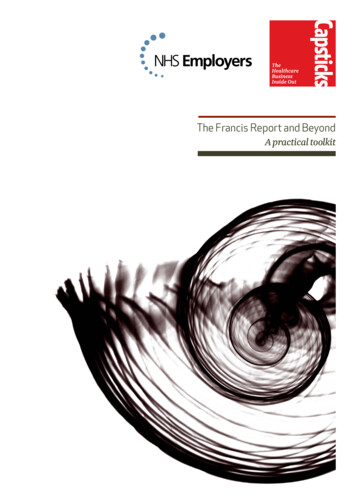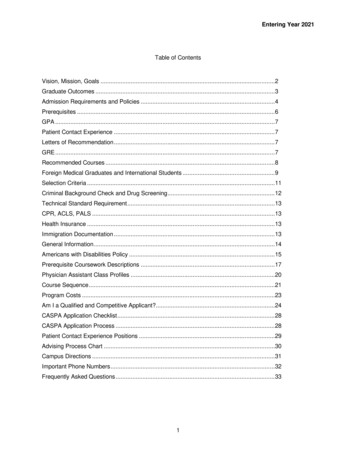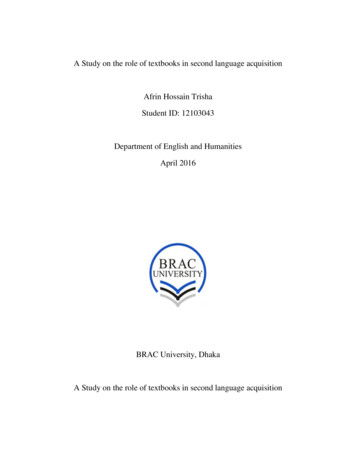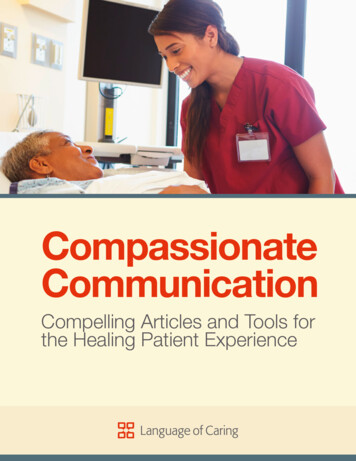
Transcription
CompassionateCommunicationCompelling Articles and Tools forthe Healing Patient Experience
WELCOME patient care leaders and patientexperience champions!Do these challenges sound familiar?zz Delivering compassionate care when staff feel stressed and, at times,demoralizedzz Ensuring patient safetyzz Breaking through the wall on CAHPS scoreszz Achieving and sustaining magnet designationzz Engaging hearts and minds of staff to provide superior care and feelgratified in their daily workOn behalf of the Language of Caring team, we are delighted to offer youthis collection of articles and tools to invigorate your efforts to meet thesechallenges head-on and provide exceptional patient, family and staffexperiences.How You Can Use These Articles and Toolszz As a shot-in-the-arm and some fresh ideas for you personallyzz As a one-topic-at-a-time focus for staff discussion and renewalCOMPASSIONATE COMMUNICATION 2017, Language of Caring , LLC
zz As food for thought, inspiration and help for your Patient Experienceplanning teamzz As a series of practical articles to circulate throughout yourorganization (e.g. in your newsletter)zz and moreWe hope you find these articles and tools inspirational, concretelyhelpful, and supportive as you advance your commitment to employeeengagement and patient-centered care.Please don’t hesitate to reach out to us with questions or to learn how wecan help you further.Warm regards,Jill Golde, Wendy Leebov and Dorothy SisnerosPartners, Language of CaringFind more tools and resources as well as information about Language ofCaring programs and services at anguageofcaring.com3COMPASSIONATE COMMUNICATION 2017, Language of Caring , LLC
About Language of Caring Language of Caring is a healthcare consulting firm led by Wendy Leebov,Jill Golde and Dorothy Sisneros. Driven by a passionate commitment tostrengthen humanism in healthcare, Language of Caring helps healthcareorganizations inspire exceptional experiences and communities of caringthrough compassionate, evidence-based communication. Language ofCaring offers a rich array of leadership development and support servicesand skill-building programs for staff and physicians—all designed toenhance the patient, family and employee experience.Our flagship program, Language of Caring for Staff , is a proven strategythat helps staff speak the Language of Caring, so patients, families andcoworkers feel their care and compassion and become more engaged,trusting, and less anxious. The results: an energized, gratified workforce,a stellar patient experience, improved safety, higher CAHPS scores, andbetter clinical outcomes.4COMPASSIONATE COMMUNICATION 2017, Language of Caring , LLC
ContentsAbout Caring Communication1. Caring CommunicationMakes the case for focusing on communicating EMPATHY and CARINGas key to breakthroughs in the patient experience82. Communication Is Not “Soft Stuff”143. Caregivers, May I Ask You?184. Dear Nurse Executive215. The POWer of Words24Skills for Communicating Caring6. The One Skill that Can Transform Health Care29Presents the research base for the connection between communicationeffectiveness and outcomes and identifies a path to developingcommunication skills within your team.Drawing on a powerful personal story, suggests critical actions thathumanize the experience of patients and families.Appreciates the profound impact nurses have on the patient and familyexperience.Highlights the importance of choosing our words so we achieve theresults we want.Explains the power of mindfulness to transform not only individualencounters with patients, families and coworkers, but also your team’seffectiveness in delivering on your mission.5COMPASSIONATE COMMUNICATION 2017, Language of Caring , LLC
7. Four Pointers on Nonverbal Communication358. “But I MEANT Well!” How The Gap Between IntentAnd Impact Affects The Patient Experience399. What Empathy Is Not!4610. “I’m Sorry”—Just Sayin’ It’s Powerful!49Engaging Patients and Families as Partners11. “No Decisions About Me Without Me!”5412. Patients, Please CUS at Me Any Time!59Challenging Situations13. Dealing with Difficult-for-Me People6514. The Maddeningly Difficult Patient7315. Commanding Respect from Disrespectful Physicians77Shares insights and illustrates behaviors that make us more effective incommunicating empathy nonverbally.Identifies what is often a gap between our intent and our impact andpresents the powerful tool of explaining our positive intent in a patientcentered manner.Identifies well-intended attempts to communicate with empathy that missthe mark.Illustrates a skill very important to communicating with empathy—theBlameless Apology and addresses the complexities when using the words“I’m sorry.”Based on personal story, sheds new light on the importance of familyengagement.Helps caregivers communicate with clarity and empathy in sticky situationswhere they want to raise a safety concern with others on the team.Redefines the notion of “difficult patients” and asks caregivers to considerlessons learned from the author’s experience with her sister.Shares advice about dealing with challenging people and illustrates the skill“Say it again with HEART.”Equips caregivers with tactics they can use to speak up when they feelothers have shown disrespect.6COMPASSIONATE COMMUNICATION 2017, Language of Caring , LLC
About CaringCommunication7COMPASSIONATE COMMUNICATION—About caring communication 2017, Language of Caring , LLC
1Caring CommunicationWENDY LEEBOV—H&HN Daily, March 26, 2013Clinicians need to make their caring commitment to their patients andfamilies explicit in words as well as actions.Motivated to serve their communities well and improve their satisfactionscores, hospitals and physicians are focusing on improving the patientexperience. Many tackle the challenge by targeting one survey item at atime. For instance, if a hospital gets a low score on the question “Howoften do nurses do everything possible to help with my pain?” it mightfocus on better pain management.Of course, the survey includes many questions, and focusing on one itemat a time leads to a revolving door of strategies. I call this method—tacklingone survey item after another—the shotgun approach. Certainly, hospitalshave improved their performance this way, but the shotgun approach oftenproves overwhelming to the staff.The other method I call the bowling approach. When you bowl, you aimfor the sweet spot—the front pin, and when you hit it well, the other pinsfall. So you aim at one improvement goal that will have an impact on many8COMPASSIONATE COMMUNICATION—About caring communication 2017, Language of Caring , LLC
others. You go after that one goal and you end up producing a positiveimpact on many others as well.The Sweet SpotLanguage of Caring has demonstrated that caring communication or, aswe call it, “the Language of Caring,” is indeed the sweet spot for improvingthe patient and family experience. When you help physicians and staffbuild their skills in communicating their empathy and you inspire them touse these skills consistently to make their caring felt, scores improve onmany survey items, even those that appear to have no connection.Communicating caring is a single breakthrough objective with an enormousimpact on the patient and family experience. It also strengthens physicianand staff satisfaction, because it earns patient trust and cooperation andhelps our care teams feel fulfillment from their caring work.Why, You Might Ask, Is Caring Communication aBreakthrough Objective?For more than 30 years, I’ve been helping health care organizations providehealing environments and healing communication for patients, families andeveryone on the health care team. During these years, the only constant inhealth care has been change:zz a growing dependence on technology: computerized medicalrecords; changing payment methods;zz changing consumer expectations;zz patient satisfaction scores on the Web for all to see; more paperwork;zz new regulations;9COMPASSIONATE COMMUNICATION—About caring communication 2017, Language of Caring , LLC
zz downsizing;zz pressure to do more with less;zz much more.For health care employees and physicians, these changes have beenwrenching.Solving the MysteryA few years ago, a chief nursing officer friend called me with news that shehad moved to a new organization where patient satisfaction scores werevery disappointing. She couldn’t figure out why and she asked me to visitand see if I could shed any new light.I wandered around. I slowed down in hallways so I could overhearconversations between nurses and patients. I shadowed a transporter toexperience his interactions with patients. And I interviewed patients andtheir family members about their care experience.To make a long story short, I saw very nice, competent, focused, busycaregivers going from task to task with deliberateness and competence.But there’s one thing I didn’t see: demonstrations of caring. People wereprimarily task-oriented—focused on their activities and their to-do lists. Isaw shockingly little in the way of caring behaviors—personal connecting,empathy, handholding or warmth. I saw caregivers who undoubtedly werecaring on the inside appear to be all business, impersonal or even detachedon the outside. And my interviews with patients and families bore this out.Patients and families were touched by a select few caregivers but, moreoften than not, they were taken aback at the lack of personal connection andcaring shown by members of the care team.10COMPASSIONATE COMMUNICATION—About caring communication 2017, Language of Caring , LLC
Expressing EmpathyIt’s good to be caring by nature—caring on the inside—but if you don’texpress it in your interactions with patients, families and coworkers, it’s asgood as absent.Example:Patient: “I’m in terrible pain. I need more medicine now!”Nurse: “Tell me more about the pain. Where is it exactly? And howwould you rate your pain from 1 to 10?”The nurse wants to address the patient’s need, but her response is entirelytask-oriented, not caring. She is caring but isn’t making her caring felt.A better example:Patient: “I’m in terrible pain. I need more medicine now!”Nurse: “I’m so sorry about your pain and I want to help! So, tell memore about it. Where is it exactly? And how would you rate it from 1 to10? I want to ease your pain!”Why better? Because in the second example, the nurse made certain toexpress her caring. And no doubt, the patient trusts that the nurse reallywants to help!People in health care are caring people. But their focus on the multitude oftasks, requirements and pressures causes this attribute to recede into thebackground. It needs to be expressed. And not only do we need to expectevery member of the health care team to communicate their caring, wealso need to help them strengthen the skills for making their caring felt.11COMPASSIONATE COMMUNICATION—About caring communication 2017, Language of Caring , LLC
The Red ThreadScripting doesn’t cut it. Making your caring felt is something that needs tobe like a red thread that you weave throughout all of your interactions. Itaffects the quality and effectiveness of everything else you do.Take the common process of rounding—a powerful, evidence-basedbest practice. Why are so many leaders disappointed in their results frominstituting hourly rounds by nurses? Because of the task-oriented way it’ssometimes implemented. A nurse can pop in and say “Need anything?”and check off that they have rounded. But rounding has powerful effectsonly if the nurse enters the room, tunes in to the patient fully, looks forclues about how the patient is feeling and what he or she needs, asksdirectly what will help the patient (using protocols such as the four P’s:pain, position, potty, possessions), then listens and responds with taskrelated actions and caring.Hundreds of interactions occur between staff and patients from arrival toadmissions:zz Transporter takes patient to room.zz Nurse greets patient, orients to room and takes history.zz Physician stops in to touch base.zz Physician or nurse explains care plan.zz Respiratory therapist coaches patient through breathing exercises.zz Housekeeper cleans room.zz Food service delivers dinner.zz Nurse holds discharge-planning conversations.zz Care manager makes follow-up phone calls.zz And many, many more.12COMPASSIONATE COMMUNICATION—About caring communication 2017, Language of Caring , LLC
The red thread needs to run through every spoken and unspokenconversation between caregiver and patient, 24/7.Caring communication is the next big thing and needs to be an enduringfocus for improving the patient and family experience.13COMPASSIONATE COMMUNICATION—About caring communication 2017, Language of Caring , LLC
2Communication Is Not“Soft Stuff”DOROTHY SISNEROS—HeartBeat, June 2016, Volume 7, Issue 90Your organization’s investment in improving the patient experience throughbetter communication will yield high returns. This has been proven timeand again throughout health care. Caring communication leads to betterpatient experiences. This benefits your organization in multiple ways: patientloyalty, higher CAHPS performance, employee engagement, quality of worklife, and improved clinical outcomes. Still, some people see communicationas “soft stuff”—not to be taken as seriously as technological advances orfinancial bottom lines. However, a recent nationwide survey of acute carehospitals published in Management Science 9 The Impact of Combining Conformanceand Experiential Quality on Hospitals%27 Readmissions and CostPerformance) and summarized in the Harvard Business Review ct-on-hospital-readmission-rates)finds that “caregivers’ ability to engage in meaningful communication withthe patient” is an essential factor in reducing readmission rates. Further,14COMPASSIONATE COMMUNICATION—About caring communication 2017, Language of Caring , LLC
the survey concludes that, to produce a higher quality patient experience,investment in tools and techniques that foster “meaningful communication”is more cost- effective than purchasing technological devices that reduceresponse time.In his book How Doctors Think, Jerome Groopman, M.D. documents theresults of poor communication, from patients leaving healthcare servicesover a misunderstanding to misdiagnoses by doctors who don’t listenattentively to patients and family members.There are financial results as well. Hospitals risk losing Medicarereimbursements if they don’t show improvement on HCAHPS scoresfor patient experience. Also, recent research finds that U.S. hospitalsdelivering a “superior” customer experience (as shown by HCAHPSscores) achieve net margins 50% higher than those hospitals that providean “average” customer experience. According to the Healthcare AdvisoryBoard, a healthcare organization could bring in millions of dollars ofadditional revenue if, by improving the experience, it encourages even asmall percentage of patients to return rather than seek care elsewhere fortheir future healthcare needs. By improving the patient experience youlower the likelihood of expensive malpractice suits too, since these aretriggered by anger resulting from poor communication more often than byphysical harm. Dissatisfied patients spread the word about their negativeexperiences, resulting in loss of referrals. Also, a positive work environmentand caring communication among staff helps retain employees—reducingthe cost of hiring and training replacements.15COMPASSIONATE COMMUNICATION—About caring communication 2017, Language of Caring , LLC
Communication Is NOT The “Soft Stuff.”Investment in communication skills should be understood as supporting—not competing with—our fundamental goal of providing excellent medicalcare. Clear and caring communication is not a luxury. It is part and parcelof quality health care. Spending money on flat screen TVs and stonefireplaces in the lobby, as some hospitals have done in an attempt toimpress patients—that is the ‘soft stuff’, expensive and with little to noimpact on patient outcomes or patient loyalty.In contrast, the relatively modest cost in time and money needed tosignificantly improve physicians’ and staff members’ communicationskills is proven to bring tangible results. It enables people to do their jobsbetter. Misunderstandings are avoided. Vital information is transmittedfrom patients and family members to caregivers. Patient loyalty and trustare built. Patients return to organizations that make them feel heard,understood, respected and cared for.Beyond Soft Skills; Beyond Basic SkillsThe skills that produce the kinds of breakthroughs described above are notsoft. They are concrete, definable and learnable. And they go beyond basicskills. The skills that healthcare professionals need to strengthen are advancedskills skills for communicating empathy, for listening open-mindedly and nonjudgmentally in the face of stress and time pressure, for engaging patients, forfacilitating joint decision-making, and for explaining so effectively that peoplefully absorb and process difficult information and life-changing messages.The small percentage of physicians who resist communication skill-buildingbecause “we learned these skills in kindergarten” may be managing the basicsjust fine, but they are overlooking the power of advanced skills to achieve anexceptional patient experience and optimal health outcomes.16COMPASSIONATE COMMUNICATION—About caring communication 2017, Language of Caring , LLC
How to Build Advanced Communication Skillswith Your Providers and Staff1. Identify champions who realize the power of strengthening providerand staff communication skills. Engage them in evaluating alternativeskill-building approaches and selecting those that are a best fit for theorganization.2. Take the time with champions to develop an elevator speech they canuse to build openness and commitment to training among colleagues.Address:zz The powerful influence of effective communication on patients andcolleagues—on their engagement and partnership, and on safety,outcomes, ratings of care, malpractice and reputation.zz The fact that communication skills required to create an exceptionalpatient experience are not soft skills, nor are they basic. They aredefinable and learnable and an advanced, beyond-the-basics skill set.3. Create and implement a skill-building strategy that is powered to changebehavior—a long-term, not one-shot strategy that includes definedcompetencies and requisite behaviors, illustrative behavioral modeling,team interaction for processing and practicing the skills, skill reminders,and opportunities for feedback and coaching.17COMPASSIONATE COMMUNICATION—About caring communication 2017, Language of Caring , LLC
3Caregivers, May I AskYou?AMY STEINBINDER—HeartBeat, April 2015 Volume 6, Issue 76My father is elderly—nearly 87 years old. That doesn’t mean that he isincompetent, infirm or uninterested regarding decisions and informationabout his body, his health and his life. Yes, it does take him longer toprocess information. So I ask you:zz Can you please speak slowly and patiently wait for his response?Yes, he is hard of hearing and he often misunderstands what you arerequesting or saying. So I ask you:zz Can you please face him directly, annunciate clearly and project yourvoice?zz Can you focus on communicating to him rather than multitasking,looking down or looking away as your voice gets redirected from himto the floor or blood pressure cuff you may be using?18COMPASSIONATE COMMUNICATION—About caring communication 2017, Language of Caring , LLC
Also, since it is his body, his health and ultimately his decisions about thecare he is receiving, I ask you:zz Can you please speak directly to him?Yes, I am in the room and I am his advocate. I am there if and when heneeds me to speak up. So I ask you:zz Can you please not assume that only I have the answers?zz Can you please not address questions to me?zz Can you please wait for him to either answer directly or look to me togive the information you are requesting?Yes, he is unsteady on his feet. He does have a healthy fear of falling andhe does move slowly. So I ask you:zz Can you please walk next to him at his pace so he isn’t reminded ofhow slow he is and doesn’t feel that he is lagging behind?Yes, he does have many chronic conditions—heart disease, arthritis, backpain, asbestosis, and a neurological disorder that is robbing him of hisshort-term memory and causing his gait to become increasingly unsteady.Yes, he does have to use supplemental oxygen 24/7, he does take severalmedications to stabilize his blood pressure and his heart function, andhe does need narcotic pain medications to reduce the constant pain heexperiences. So I ask you:zz Can you please convey to him that despite all of the challenges thathe faces every day that you admire him for his tenacity and his abilityto keep moving forward?Please recognize that he has experienced tremendous losses. You may notknow about them all (significant ones - loss of his wife of 60 years, loss ofhis 25-year old son over 25 years ago, loss of his sister-in-law, brother-in-19COMPASSIONATE COMMUNICATION—About caring communication 2017, Language of Caring , LLC
law, aunts, uncles, cousins and many close friends), but I imagine that forany elderly man, loss is a significant part of life. So I ask you:zz Can you please ask him about his life, his family and the people whoare important to him?Yes, his purpose in life is rapidly changing. He no longer has his wife andchildren who depend on him. He no longer drives. He is unable to do hisown cooking and take care of his home. He has transitioned from beingtotally independent to now being dependent on others. So I ask you:zz Can you listen intently and help him think about a new purpose for hislife? We in his immediate family struggle with this and will appreciateany light you may be able to shine.So, as I end my seemingly unending barrage of questions, I ask you onefinal question:zz How can you ease the burden, the confusion and the angst of yourelderly patient who is my elderly father and use your voice, your earsand your heart to ease the transitional journey for him and for me?20COMPASSIONATE COMMUNICATION—About caring communication 2017, Language of Caring , LLC
4Dear Nurse ExecutiveRHONDA WILLIAMS—Language of Caring blog, February 2017I want to give you warm and heart-felt thanks for all you do every day.Doing the work of Angels is not easy but without you, patients and familiescould not experience the care necessary to heal. The work you do goesso far beyond what is obvious to the eye. As a former Nurse Executive, Iunderstand how much of you is required to accomplish even small bits ofprogress in the midst of the major challenges you face.Nursing is at the heart of hospital care and has a tremendous impacton patients, families and the entire healthcare team. If nursing is notperforming optimally, every stakeholder feels it. In a society where manyfeel nursing is an under-appreciated profession, I want you to know you arevalued and respected by so many both in and out of your organization.Patients and FamiliesIt goes without saying that patients and families are the reason we do whatwe do. They come to your hospital needing your services when they are intheir most vulnerable state. They may be afraid, frustrated, or angry. While21COMPASSIONATE COMMUNICATION—About caring communication 2017, Language of Caring , LLC
you may not be privy to the past experiences that shape their perspectives,you understand that their feelings, symptoms, and perceptions resultfrom something bigger. You stay focused on providing the unbiased andcompassionate care they want and deserve. Please know for every ‘thankyou’ received, there are probably hundreds more that patients and familiesdid not express.Executive TeamYour willingness and commitment to rise to challenges and highexpectations is the difference between having a harmonious and highaccountability team and a dysfunctional, ineffective team. You are thedriver of alignment—and the glue that bonds and helps sustain alignmentamong many departments. You acknowledge the work to be done whileadvocating for your team so that they give and receive the respectand caring everyone deserves for their noble work and commitment topatients and each other. I cannot recall many meetings where the topicof “what nursing should be doing” did not arise. It can be exhausting anddisheartening, making you wonder, “Do they understand how hard we areworking.” Please know, even if it is not felt at that moment, the work by youand your team does not go unrecognized.Nursing LeadersAll I can say to you is WOW! Your incredible leadership has the ability totouch lives and transform careers. You congratulate publically and coachprivately. Your skillful navigation of the generational divide contributesto a cohesive team focused on the goal of providing each and everypatient with an exceptional patient experience. But it does not stop there.You understand that team relationships, both interdepartmental and22COMPASSIONATE COMMUNICATION—About caring communication 2017, Language of Caring , LLC
intradepartmental, have a powerful impact on outcomes. You hold theteam accountable for high expectations while fostering an environmentthat is blame-free and education-centric. Whether you offer a hug to thenurse who just experienced a personal loss or a high five and, of course,pizza when the team pulls through a challenging clinical situation, you doall you can do to be there for your team.Ancillary DepartmentsIn my early days as Nurse Executive, I remember feeling overwhelmed aseach department shared what they needed from Nursing. It was so difficultto prioritize all of these needs. But you do! And, more importantly, you doit in a way that makes other department leaders feel valued and respected.Others leave conversations with you feeling pride in knowing you are theultimate collaborator and, although your plate is full, you are always opento talk. You approach each situation with the big picture in mind. You knowthat every department is important to the exceptional patient experience.You embrace your role and lead the charge!I could go on, but suffice it to say, your leadership helps transformorganizations so that they replace tragic outcomes with consistently magicoutcomes. Please know how incredibly valued you are, and thank you fordoing the amazing work you do every day!23COMPASSIONATE COMMUNICATION—About caring communication 2017, Language of Caring , LLC
5The POWer of WordsWENDY LEEBOV—HeartBeat, March 2013, Volume 5, Issue 2I just came across an impressive study that reminded me of the dramaticpower of words. The study reveals the difference in patient outcomes whena primary care physician asks, “Is there anything else concerning you?”versus “Is there something else concerning you?” Patients hear “anythingelse” as an attempt to close the encounter, while they hear “somethingelse” as a door-opener to an unmet concern. The researchers foundthat the use of the word “some” instead of “any” eliminates more thanthree-quarters of all cases of unmet concerns! (Heritage, Robinson et al.,Reducing Patients’ Unmet Concerns in Primary Care: The Difference OneWord Can Make, J Gen Intern Med. 2007 October; 22(10): 1429–1433.)This reminder of the power of words sent me to my files to locate my notesfrom a patient focus group I conducted a few years ago when I first becameobsessed with defining the language of caring. I wanted to learn frompatients and families about the words we use as healthcare professionalsand their impact on patient and family feelings and behavior. I invitedexamples of words that create a negative impact—that are discouraging,insulting, annoying or otherwise trigger resistance or disengagement.24COMPASSIONATE COMMUNICATION—About caring communication 2017, Language of Caring , LLC
I also pumped for words we use that make patients and families feel good,motivated, cared about, cooperative and special.Words and Phrases with a Negative Impact(I call these “Killer Words.”)You sayThe patient or customer hearsAs soon as possible.When I get around to it.Hopefully Who really knows?I’ll try.Not sure I can do it. No promises here.To be honest.I was lying up until now.I can’t do that.I won’t do that.It’s our policy.That’s against our policy.That’s the way it is. Like it or lump it.It’s over there.I’m too important to show you the way.You have to You must I’m in charge here. I made the rules and youfollow them.The truth is I probably shouldn’t tell you this.Calm down.You’re out of control and you’re the problemhere.That’s not my department, You’ll have tospeak with someone else.It’s not my problem and I won’t help.If you read our policy If you had read the directions You should have Dummy.Like I said You’re irritating me and wasting my time.You can’t I set the rules here. You don’t.What’s your problem?Ugh, another demanding person!Yes, but No.25COMPASSIONATE COMMUNICATION—About caring communication 2017, Language of Caring , LLC
Words and Phrases with a Positive Impact(I call these “Healing Words”)You sayThe patient or customer hearsI can certainly help you.I’m here for you, for sure.I’ll gladly arrange that.You can count on me to come through foryou.Delighted.You’re not a bother at all. I’m here for you.Absolutely.You can’t count on me.My pleasure.It’s a joy to help you.I’m happy to I love my job.I’m really sorry I sincerely regret that you had an unfortunateexperience.Yes.It’s clear. You can count on it.What I can do is I really want to help somehow.I’m asking you to I’d appreciate it if you would How may
2017, Language of Caring , LLC 9 others. You go after that one goal and you end up producing a positive impact on many others as well. The Sweet Spot Language of Caring has demonstrated that caring communication or, as we call it, “the Language of Caring,” is indeed the sw


